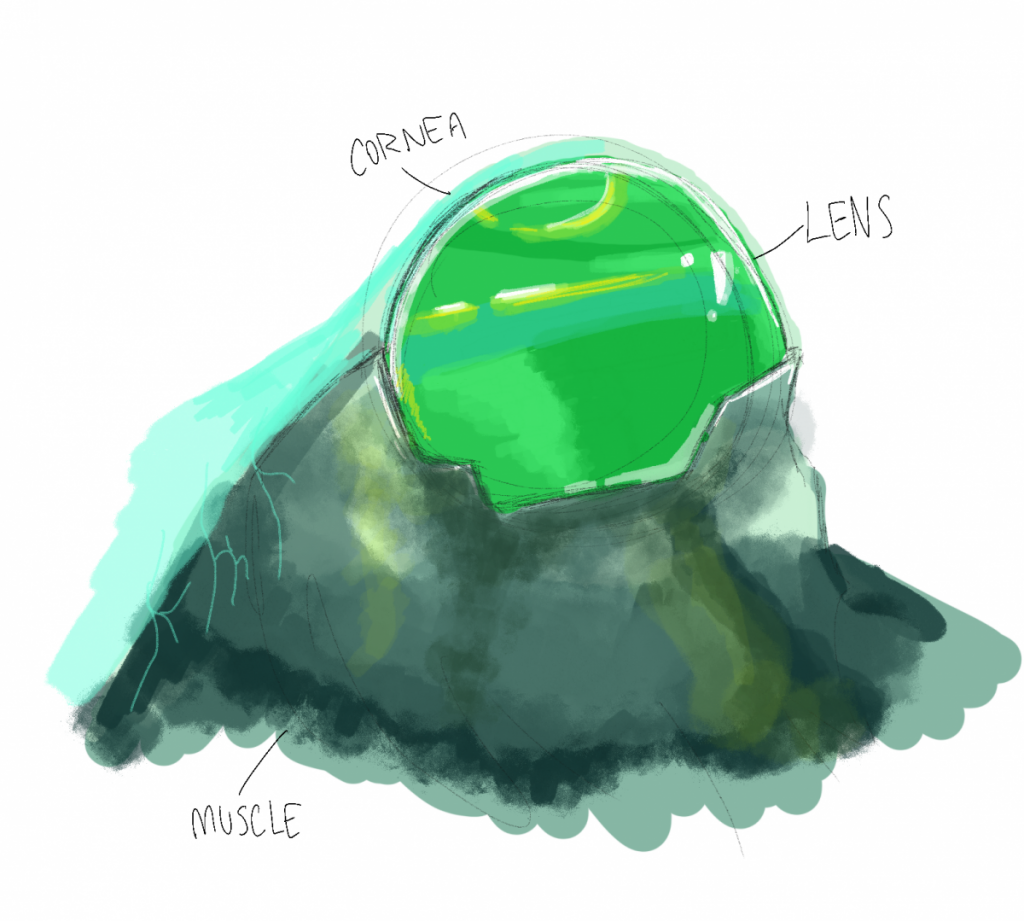When living in a world of complete darkness, it’s crucial to develop a way to detect one’s surroundings in order to survive. Having the ability to find light in such an environment would be an advantage over an abundance of predators and prey alike. The Macropinna Microstoma, or Barreleye fish, depends on its vision to persevere in the harsh deep sea. It’s known for the bulbous, green eyes that rest within its transparent head, which can detect sunlight at a depth mankind needs robotics to reach. The behavior, movement, and appearance of the Barreleye all work to represent the truly alien world of the oceanic depths.
The eyes of the Macropinna Microstoma are adept tools designed to collect light. They are tubular, meaning they contain a massive lens and a multilayer retina, which are used to capture the maximum amount of light from a specific direction. (MBARI) When hit by light, the eyes glow a vibrant, reflective green color. The source of the green pigment is the large lense that takes up the majority of the eye itself. The lens is surrounded by tight muscles that naturally rest in the upright position, but are able to rotate the eye forward when needed. Because of this, the Barreleye is most commonly seen looking up rather than in any other direction.

The large, green eyes of the Macropinna Microstoma are located within a transparent dome that makes up the majority of the fish’s head. This dome is filled with fluid that protects the eyes, but is known to be easily destroyed upon capture of the fish. The Barreleye’s body is barrel shaped and covered in large scales. Its fins are very big in comparison to the rest of its body, whereas its mouth is notably small and thin. The bulging spots above the mouth are very similar to nostrils and contain olfactory organs. (MBARI)

The Barreleye fish is rarely captured swimming freely in open water. For the majority of the time recorded by biologists, the fish remains motionless with its eyes pointed upwards as it waits for potential prey to swim overhead. Because of this, the eyes of the fish also rarely seem to move. When they do move, it is typically done in tandem with the rest of the body as the Barreleye shifts from the horizontal position to vertical. Once it sees a target above, the fish will begin to swim upwards while keeping its eyes locked on the prey. The body of the fish therefore moves around its eyes until they are pointing forwards rather than upwards, despite the fact that the eyes are never removed from their target.

Drawing from the context of the Barreleye’s physical attributes, as well as its recorded behavior, it’s easy enough to infer on the lifestyle of the Macropinna Microstoma. It’s safe to assume that this fish does not actively seek out its prey by hunting, but rather lies in wait for food to either drift or swim by above. This can be assumed because its fins are designed to remain motionless in the water for long periods of time. If the Barreleye does not chase down its prey, however, that would also imply that its food of choice is slow, or something that simply floats by. It would also need to be something small, so to fit inside the tiny mouth of the Barreleye. Some captured Barreleyes actually contained small jellyfish in their digestive tract, and many biologists theorize that the fish actually steals its food from the tentacles of Siphonophores. (MBARI)
If I were a Barreleye fish, my life would be completely dependent on my eyes. I would thrive in darkness that most other creatures would find themselves helpless in because my eyes are specially designed to see everything. The bioluminescence of my prey would simply work to my advantage, as I lie in wait for their silhouette to pass overhead. Without my advanced vision, however, I would be completely helpless in the depths. And so I am also dependent on the dome shield that surrounds my eyes. With its protection, I can slip between the tentacles of siphonophores safely and steal the captured copepods for myself. My life is slow and dark, but I am a patient creature that understands how to observe my surroundings until I find the best moment to strike.

Bibliography
- Robison, Bruce & Reisenbichler, Kim. “Macropinna microstoma and the Paradox of Its Tubular Eyes.” Copeia. 2008. 780-784. 10.1643/CG-07-082.
- Partridge, J C, et al. “Reflecting Optics in the Diverticular Eye of a Deep-Sea Barreleye Fish (Rhynchohyalus Natalensis).” Proceedings. Biological Sciences, vol. 281, no. 1782, 2014, p. 20133223.
- MBARI. “Researchers Solve Mystery of Deep-Sea Fish with Tubular Eyes and Transparent Head.” MBARI, 10 July 2017, www.mbari.org/barreleye-fish-with-tubular-eyes-and-transparent-head/.
- National Geographic. “Fish With Transparent Head Filmed.” National Geographic, https://video.nationalgeographic.com/video/news/00000144-0a31-d3cb-a96c-7b3d3de20000.
